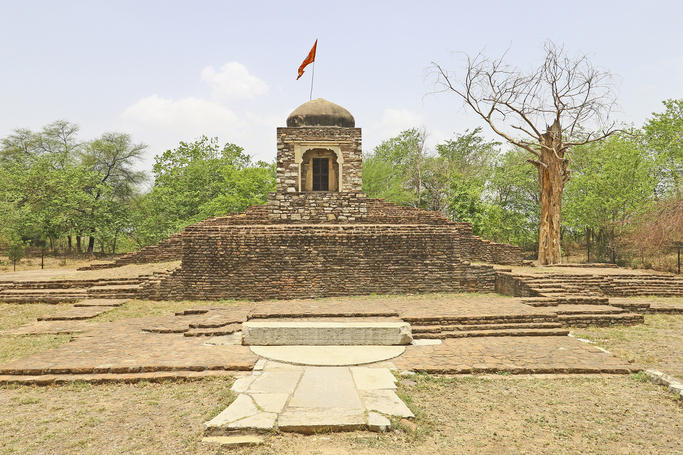
Nagari or Madhyamika Nagari is situated near Chittor. It remained prosperous for a pretty long time. The Mahabaharata has several references pertaining to this place. Nagari is eight miles north of Chittaurgarh . The place was first visited in 1872 CE by A.C.L. Carlleyle , Assistant to Sir Alexander Cunningham, and his account of its antiquities is published in 'Archaeological Suvey of India Reports, Vol. VI, pp.196-226.' Kavi Raj Shyamal Das, a Charan of high rank and fame in the court of Udaipur, and perhaps the most celebrated antiquarian and historian of his time in Rajputana, visited Nagari soon after and published an article entitled Antiquities at Nagai, in the Journal of the Asiatic Society of Bengal, Vol. LVI,Pt. I p. 74 ff.
The old temple was constructed for the worship of Sankarshana and Vasudeva. It is a temple surrounded by a stone wall. It covers a large area, the outer measurement of which are : 300 ft. 4 inches by 150 ft. 4 inches. Its inner area is 291 ft. by 148 ft. 6 inches. it is believed that there was a Chabutara (Platform) inside the enclosure on which the figures of Sankarshana and Vasudeva were placed. It was an open temple where regular worship was performed. Perhaps the Ubh-Dival or big pillar was erected infront of the temple. Later, it was removed by Akbar in 1567 CE and fixed to serve as a beacon of light for his armies kept stationed there. The stones in Puja-shila Prakara and Ubh- Dival are grey in colour, which have become dark by exposure. No lime plaster has been used in the construction work.
Other contemporary Vaishnava temples also have the figures of Garuda-Dhwaja . Dr. Bhandarkar (1915-16)(Report 1920, Reprint 1998) , who carried the excavations at Nagari, believes that the Ubh-Dival remained a pyramidal tower constructed by 21 huge square blocks of lime stones closely fitted to one another. This is the earliest Vaishnava temple of Rajasthan.
The structures were built by Gajayana Sarvtat , a local ruler. The temple was known as Narayan- Vatika. Sarvtata was a powerful ruler who performed the Asvamedh-Yajna. A seal bearing the name of Sarvtata is also known from Sambhar. Two Vaishnavite inscriptions of the second century BCE records the performance of an Asvamedha sacrifice one by Sarvatata and another of Vajapeya sacrifice , while a third inscription refers to the erection of a Vishnu temple in the first quarter of the 5th century CE. In the beginning of the 4th century CE the imperial Guptas came to power. Samudra Gupta defeated the Malavas and extracted tribute from them. He was succeeded by Chandra Gupta, who annexed Avanti by defeating the Kshtrapa rulers. Perhaps, Nagari was also under the Guptas. The inscription of V.E. 481 (424 CE) mentions that a temple of Vishnu was constructed by Satya Sur, Srigandh, Das and others. These persons do not belong the any royal family. Similarly, a fragment of a Yupa pillar discovered at Nagari (4th - 5th century CE) contain an account of the performance of Vajpeya YaJna there by some ruler, whose name has been obliterated. Soon after the territory around Nagari was ruled by the local rulers of Mandsaur, who were the tributaries of the Guptas.
Out of a large number of loose sculptures and architectural elements found by Dr. Bhandarkar (1915-16), two are carved pillars of the Gupta period having lion and bull capitals respectively. Others comprise old railings, coping stones and sculptures representing revanta on a horse and Kiratarjuniyam . It is said that Nagari was invaded by Demetrius or Menender, the Greek rulers. Patanjali , the Grammarian, who was a contemporary of Pushyamitra Sunga, mentions this fact. The Greeks passed though Madhyamika Nagari, Daspur and Anvalesvar to Hadoti. Due to repeated Yavan invasions, Sibis, a republican tribe of Punjab, moved towards Rajasthan and settled at Nagari. A good number of coins bearing the legend 'Madhyamika-Sibi-Janpadasa' have been noticed from Nagari. Some Buddhist Stups were noticed from Nagari. One stupa was having moulded bricks and terracottas of high artistic fineness. The Nagari teracotta can be grouped in three types- (i) moulded bricks with human busts (ii) moulded bricks with animmals in profile and (iii) moulded bricks with floral decorations. Dr. Bhandarkar advocates that the art of moulded bricks and clay plaques has nothing to do with the Gandhara Art. The molded bricks showing ripple and date-palm decoration, the lower part of a human figurine seated on a chair, lotus, flying birds and human heads formed architectural components of the temple. In the excavation, three periods were distinguished, the first two being interior to the stone fortification and seemingly without baked brick structures, though limestone structures were known. The report mentions both Red and Grey Wares, the occurrence of the NBPW was negligible, though the associated Red Ware was available. The settlement seems to have originated in circa 400 BCE but both on the surface and sporadically in the lower levels, fluted cores and flakes were found. Period III was marked by the presence of the Red Polished Ware. Other finds of the site include terracotta human and animal figurines in Sunga and Gupta styles, toys and flesh-rubbers, an ivory seal with swastika and terrine symbols and copper antimony rods and rings. The fortification probably originated in the Gupta times.